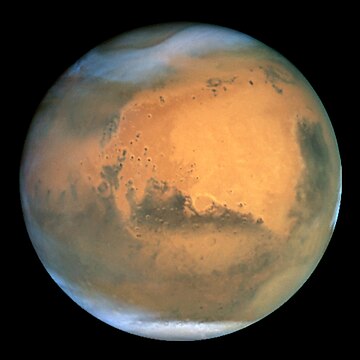Mangalgrah (pratiik: ![]() , Mars) Solar System me Suraj se dur chhota planet hae. English me iska naam, Mars, Roman ke yudh karne waala bhagwaan ke naam se aisa hae kyoki iska rang laal hae joki khuun ka rang hae.
, Mars) Solar System me Suraj se dur chhota planet hae. English me iska naam, Mars, Roman ke yudh karne waala bhagwaan ke naam se aisa hae kyoki iska rang laal hae joki khuun ka rang hae.
 | ||||||||||
| Orbital characteristics[1] Epoch J2000 | ||||||||||
|---|---|---|---|---|---|---|---|---|---|---|
| Aphelion | 249,209,300 km 1.665 861 AU | |||||||||
| Perihelion | 206,669,000 km 1.381 497 AU | |||||||||
| Semi-major axis | 227,939,100 km 1.523 679 AU | |||||||||
| Eccentricity | 0.093 315 | |||||||||
| Orbital period | 686.971 day 1.8808 Julian years | |||||||||
| Synodic period | 779.96 day 2.135 Julian years | |||||||||
| Average orbital speed | 24.077 km/s | |||||||||
| Inclination | 1.850° to ecliptic 5.65° to Sun's equator 1.67° to invariable plane[2] | |||||||||
| Longitude of ascending node | 49.562° | |||||||||
| Argument of perihelion | 286.537° | |||||||||
| Satellites | 2 | |||||||||
| Physical characteristics | ||||||||||
| Equatorial radius | 3,396.2 ± 0.1 km[a][3] 0.533 Earths | |||||||||
| Polar radius | 3,376.2 ± 0.1 km[a][3] 0.531 Earths | |||||||||
| Flattening | 0.005 89 ± 0.000 15 | |||||||||
| Surface area | 144,798,500 km² 0.284 Earths | |||||||||
| Volume | 1.6318×1011 km³ 0.151 Earths | |||||||||
| Mass | 6.4185×1023 kg 0.107 Earths | |||||||||
| Mean density | 3.934 g/cm³ | |||||||||
| Equatorial surface gravity | 3.69 m/s² 0.376 g | |||||||||
| Escape velocity | 5.027 km/s | |||||||||
| Sidereal rotation period | 1.025 957 day24.622 96 h[4] | |||||||||
| Rotation velocity at equator | 868.22 km/h (241.17 m/s) | |||||||||
| Axial tilt | 25.19° | |||||||||
| Right ascension of North pole | 21 h 10 min 44 s 317.681 43° | |||||||||
| Declination of North pole | 52.886 50° | |||||||||
| Albedo | 0.15 (geometric) or 0.25 (bond) | |||||||||
| Surface temperature: Kelvin Celsius |
| |||||||||
| Apparent magnitude | +1.8 to −2.91 | |||||||||
| Angular size | 3.5—25.1" | |||||||||
| Adjectives | Martian | |||||||||
| Atmosphere | ||||||||||
| Surface pressure | 0.6–1.0 kPa | |||||||||
| Composition | 95.72% Carbon dioxide 2.7% Nitrogen | |||||||||
Mangalgrah ka jaankari

Mars ke lage hue chhota chhota chandrama hae, jiske naam Phobos aur Deimos he. Is planet me jaada kar ke patthar he. Iski matti laal he kahe ki hian pagal ho gaye hae pe dher iron oxide (murcha) hae.[5] Ii planet me thorra se carbon dioxide ke atmosphere hae. Mangalgrah ke temperature dunia se aur jaada thanda hae, kahe ki ii Suraj se aur duur har. Mangalgrah ke north aur south pole me ice aur frozen carbon dioxide hae. Mars me paani nai hae, poles ke alawa, lekin scientist log ii soche hae ki hian pe pahile paani rahaa.
Mangalgrah ka Itihaas
Mangalgrah ke baare me pichhle kai varso se jaana jata hae. Greek log is planet ko Ares khte the , lekin jab Roman log raj karne lage tab ve log iske naam ko badal kr Mars ka nam de diya.
Ii planet ke chapa banae me pahila kaam Giovanni Schiaparelli karis rahaa. Ii jon kuchh aapan duurbin se dekhis rahaa uske confuse kar diis kahe ki uu canal ke jiske paani ke khatir khoda gias rahaa, ke dekhis. Iske kaaran log ii soche lagin ki Mangalgrah me janwar aur alien rahe hae. Aajkal ii planet me rocket bheje ke kaaran ham log ii jantaa hae ki ii planet me koi janwar nai hae.
References
Dusre websites
Wikiwand in your browser!
Seamless Wikipedia browsing. On steroids.
Every time you click a link to Wikipedia, Wiktionary or Wikiquote in your browser's search results, it will show the modern Wikiwand interface.
Wikiwand extension is a five stars, simple, with minimum permission required to keep your browsing private, safe and transparent.
